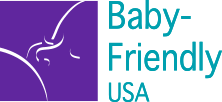The Ten Steps to Successful Breastfeeding are the broad framework that guide the Baby-Friendly Hospital Initiative. They were developed by a team of global experts and consist of evidence-based practices that have been shown to increase breastfeeding initiation and duration, and were updated in 2018. Baby-Friendly® hospitals and birthing facilities must adhere to the Ten Steps to receive, and retain, a Baby-Friendly designation. The Ten Steps to Successful Breastfeeding are:
CRITICAL MANAGEMENT PROCEDURES:
1 A. Comply fully with the International Code of Marketing of Breast-milk Substitutes and relevant World Health Assembly resolutions.
1 B. Have a written infant feeding policy that is routinely communicated to staff and parents.
1 C. Establish ongoing monitoring and data-management systems.
2. Ensure that staff have sufficient knowledge, competence and skills to support breastfeeding.
KEY CLINICAL PRACTICES:
3. Discuss the importance and management of breastfeeding with pregnant women and their families.
4. Facilitate immediate and uninterrupted skin-to-skin contact and support mothers to initiate breastfeeding as soon as possible after birth.
5. Support mothers to initiate and maintain breastfeeding and manage common difficulties.
6. Do not provide breastfed newborns any food or fluids other than breast-milk, unless medically indicated.
7. Enable mothers and their infants to remain together and to practice rooming-in 24 hours a day.
8. Support mothers to recognize and respond to their infants’ cues for feeding.
9. Counsel mothers on the use and risks of feeding bottles, artificial nipples (teats) and pacifiers.
10. Coordinate discharge so that parents and their infants have timely access to ongoing support and care.
The Ten Steps are endorsed and promoted by the major maternal and child health authorities in the United States, including:
The International Code of Marketing of Breast-Milk Substitutes
One of the tenets of the Baby-Friendly Hospital Initiative is that the marketing of breast-milk substitutes, including infant formula, discourages mothers from initiating and/or exclusively breastfeeding their infants. The International Code of Marketing of Breast-Milk Substitutes, adopted by the WHO in 1981, calls for restrictions on the marketing of breast-milk substitutes, infant feeding bottles, and teats. Hospitals and birthing centers wishing to attain and retain Baby-Friendly designation must abide by the provisions of the International Code of Marketing of Breast-Milk Substitutes.
Significant provisions of this code prevent hospitals and birthing centers from accepting free or low-cost infant formula, providing free samples of infant formula to families, or advertising breast-milk substitutes. Provisions of the International Code of Marketing of Breast-Milk Substitutes require:
- No advertising of breast-milk substitutes to families.
- No free samples or supplies in the health care system.
- No promotion of products through health care facilities, including no free or low-cost formula.
- No contact between marketing personnel and mothers.
- No gifts or personal samples to health workers.
- No words or pictures idealizing artificial feeding, including pictures of infants, on the labels or product.
- Information to health workers should be scientific and factual only.
- All information on artificial feeding, including labels, should explain the benefits of breastfeeding and the costs and hazards associated with artificial feeding.
- Unsuitable products should not be promoted for babies.
- All products should be of high quality and take account of the climate and storage conditions of the country where they are used.
Learn More
The entire International Code of Marketing of Breast-Milk Substitutes document is available online at the World Health Organization’s website.
Get important updates from BFUSA:

